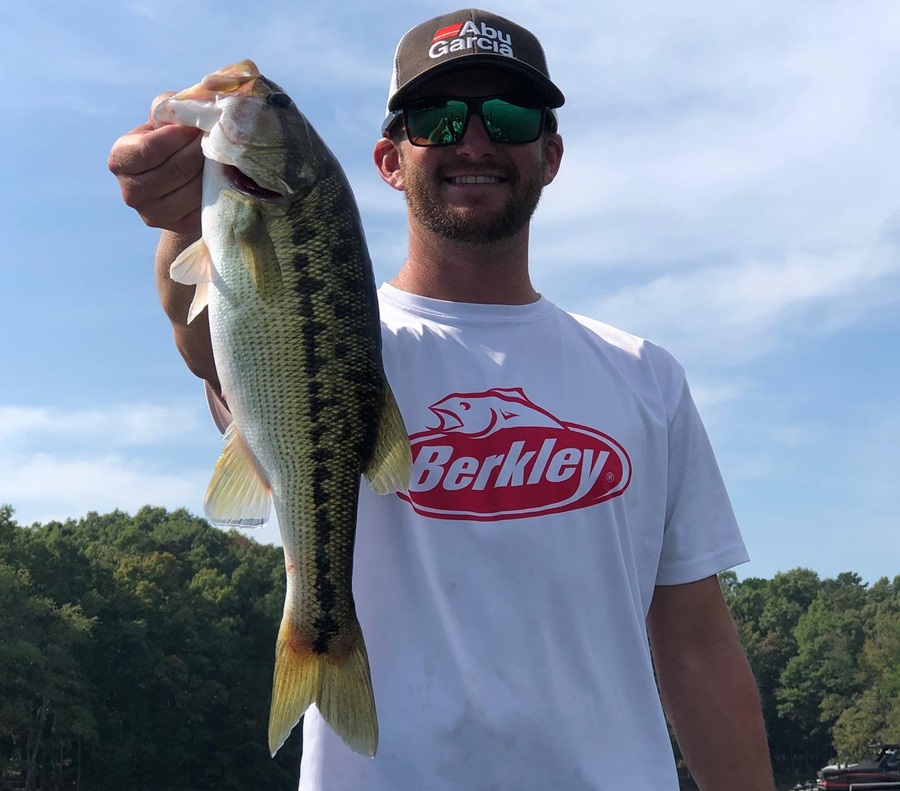 It's been quite some time since the Alabama rig or umbrella rig first hit the national scene in 2011, and it's still catching fish. While it's banned at top-level competitions, like in the Bassmaster Elite Series that North Carolina's Shane LeHew competes in, he still uses it when he's home. Even though he can't use them in his life as a pro angler, he fishes them regularly when competing in local tournaments on Lake Norman throughout the winter months.
It's been quite some time since the Alabama rig or umbrella rig first hit the national scene in 2011, and it's still catching fish. While it's banned at top-level competitions, like in the Bassmaster Elite Series that North Carolina's Shane LeHew competes in, he still uses it when he's home. Even though he can't use them in his life as a pro angler, he fishes them regularly when competing in local tournaments on Lake Norman throughout the winter months.
LeHew is an A-Rig fanatic and he and his father have run Shane's Baits for many years, producing an excellent rig with many fans nationwide. Right now is when LeHew gets to fish around home, and it's also the perfect time to throw an A-rig, and he shared some tips on getting the most out of them.
Be the first
When this rig first came out, it seemed like the fish couldn't do anything but eat it, mainly because they had never seen it. LeHew keeps this mindset and tries to get on the bite early every year before everyone throws it just as the weather gets colder.
"If you can be the first to throw it right when the water starts to cool down, you can have some great fishing," he said. "I won a tournament a couple of months ago on one, fishing right down the sides of docks. It's almost like the bass forget about it, and I was catching doubles on it all day."
 Choosing the proper rig and swimbaits
Choosing the proper rig and swimbaits
LeHew says that his main goal is to have a rig that is as big and flashy as possible, and for him back home in North Carolina, that's the Shane's Baits Blades of Glory, which has a nine-hook setup and tons of blades.
"I want it to look like the biggest school of baitfish I can," he said. "Some states don't allow that many hooks, so I'll always use as many as you are allowed."
One the rigs, he typically uses 2.8-inch Berkley Powerbait Power Swimmer swimbaits on 1/16-ounce jigheads but will go a little bigger on lakes with more gizzard shad and switch to ¼-ounce Berkley Fusion19 Swimbait jigheads when fishing deeper water.
"Those are great swimbaits that are much more durable than others on the market," he said. "If your baits are too soft, you'll be replacing them all day long. The action is also a little tighter on the Power Swimmer, which I like for my rigs."
LeHew generally sticks with a handful of shad patterns, but he always has one solid pearl white swimbait. "A lot of times, that's the one that the fish will eat," he said. "Even if they don't eat that one, I think the bright white helps to draw them to the rig."
Pick the right line
There are three line type options, but LeHew is always going with fluorocarbon and he uses 25-pound test Berkley Trilene 100% fluorocarbon for the strength and how the bait performs.
"Line size doesn't matter because the rig is already pretty visible, so I go as heavy as possible," he said. "I like the sink rate better from fluorocarbon than I do with mono or braid. Plus, braid tends to dig into your reel after you catch fish. Many times, the next cast, it will lock up, and you risk snapping it off midcast."
He also likes a 25-pound test because he's more likely to get his rig back if it hangs up. "You can straighten out those hooks and get your rig back, even if you hook into a brush pile," he said. "I'd much rather replace a jighead than lose the whole thing."
 Rods and reels matter
Rods and reels matter
LeHew says that many anglers use rods that are too stiff and he's settled on a great rod, an Abu Garcia rod designed for punching. He said it's ideal for A-Rigs as well because of the bend.
"It's a 7-foot, 6-inch rod designed by Hunter Shryock for punching, but it's got the perfect bend to it for a rig," he said. "I use a REVO Beast in the 5.8:1 gear ratio, which is the perfect speed to control your bait."
Generally, LeHew is fishing his rigs with a steady retrieve, but he's careful to keep the bait just above cover. "Using Livescope has made it much easier on us," he said. "I like to wind it just above cover, whether it's a brush pile, rocks, or trees. It's also good to wind down the sides of the dock. You can do many different things with it."
Even though the A-Rig isn't allowed in most professional tournaments, pro anglers still love throwing them. Shane LeHew fishes them all winter because he believes it's the perfect thing to throw when bass are grouped up and eating baitfish.


 Advertising
Advertising